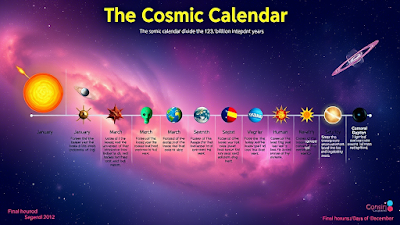"The Cosmic Calendar: Visualizing the Universe’s 13.8 Billion-Year Journey in 12 Months"
Discover the Cosmic Calendar—a revolutionary way to understand the universe’s 13.8-billion-year history compressed into 12 months. Explore key cosmic events, scientific evidence, and humanity’s fleeting yet profound role in this grand timeline.
The universe’s 13.8-billion-year history is unimaginably vast. To make sense of this cosmic timespan, astronomer Carl Sagan introduced the Cosmic Calendar in his 1977 book The Dragons of Eden. This brilliant analogy condenses the universe’s entire timeline into a single year, where each month represents roughly 1.15 billion years. In this blog, we’ll unravel the Cosmic Calendar, backed by cutting-edge scientific research, and explore how humanity’s entire existence occupies less than the final seconds of December 31.
What Is the Cosmic Calendar?
• 1 Year = 13.8 billion years (the universe’s current age).
• 1 Month ≈ 1.15 billion years.
• 1 Day ≈ 37.8 million years.
• 1 Second ≈ 438 years.
• The Big Bang, the event that created the universe, happens at midnight on January 1st.
• The present day is midnight on December 31st.
• Each second on the Cosmic Calendar represents about 437 years of real time.
• Each day on this calendar equals roughly 37.8 million years.
By scaling down the universe’s history into a 365-day year, the Cosmic Calendar helps us grasp the immense timeline of cosmic events and shows just how recent human history is in the grand scheme.
How Does the Cosmic Calendar Work?
Here’s the breakdown:
• The universe is 13,800,000,000 years old.
• A year has 31,536,000 seconds (365 days × 24 hours × 60 minutes × 60 seconds).
• Divide the universe’s age by the seconds in a year:
13,800,000,000 ÷ 31,536,000 ≈ 437 years per second.
This means:
• 1 day on the Cosmic Calendar = 37.8 million years.
• 1 month ≈ 1.15 billion years.
With this scale, let’s walk through the major events in the universe’s history.

Post a Comment